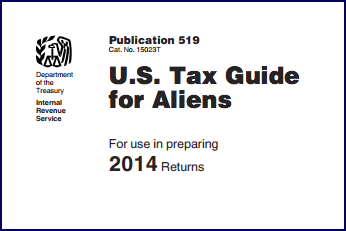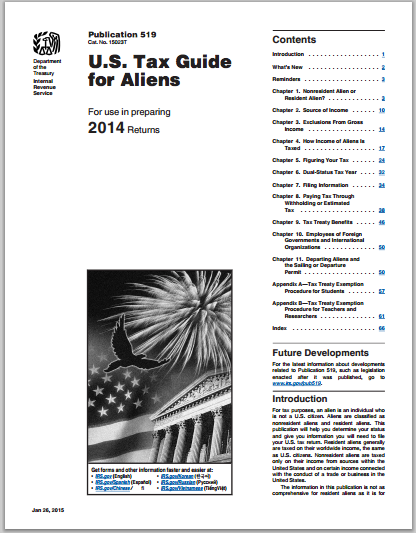What You Need to Know About IRS Publication 519
Publication 519 is provided by the Internal Revenue Service (IRS) to assist in tax preparation for both resident and non-resident aliens. Among other things Publication 519 helps you to determine whether you are a resident, non-resident alien or if you fall under both classifications; what income may be subject to tax; how income of aliens is taxed; and where, when and how you should file your income tax forms.
Your first step, for tax purposes, should be to determine if you are a resident or non-resident alien. If you qualify as both resident and non-resident in the same year, you have what is referred to as dual status. If you are married, you may also have a choice of treating your non-resident spouse as a resident alien. Your status is determined by either the “Green Card” test or the “Substantial Presence” test. However, even if you do not meet the requirements of either test you may be able to choose to be treated as a United States resident for part of the year.
After you have determined your residency status, your next step is to determine what income is subject to taxes. As a Resident alien, income is generally subject to tax treatment in the same manner as a U.S. citizen. Non-resident aliens are generally subject to U.S. taxes only on income earned from U.S. sources. However, not all income from U.S. sources is subject to income tax.
How Your Income is Taxed

Resident and non-resident aliens are taxed in different ways. Resident aliens are generally taxed in much the same way as U.S. citizens.
What this means is that the residents alien’s worldwide income is subject to U.S. tax and must be reported on his/her tax return. The same graduated tax rates that apply to U.S. citizens will apply to a resident alien.
Income for a non-resident alien will be divided into two categories:
- Income that is effectively connected to a United States trade or business; and
- income that is not effectively connected to a United States trade or business.
The difference between the two categories will be the rate in which the income is taxed. The effectively connected income is subject to the same graduated rates discussed above. The non-effectively connected income is taxed at a flat 30% rate.
As you can see, Publication 519 is a complicated document that also refers to several other IRS publications. When it comes to figuring out which tax status is right for you and which, if any, income is subject to U.S. taxes it is best to consult an experienced tax lawyer.
An experienced tax lawyer can help you to minimize your taxes and reduce the risk of costly audits. They will also help you wade through the complexities of the U.S. tax code.









